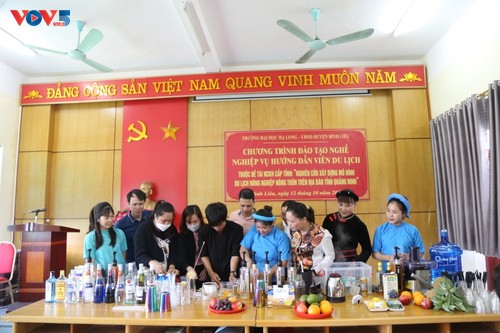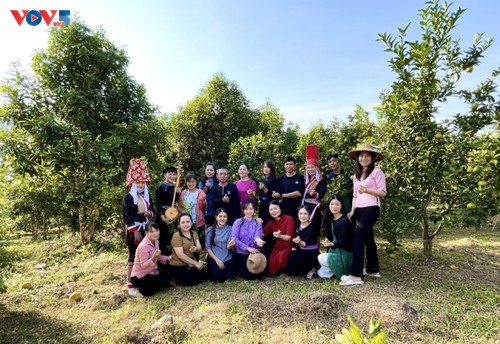 Ethnic women learn to make fruit juice and cocktails to serve tourists. (photo: Huyen Chi/VOV) Ethnic women learn to make fruit juice and cocktails to serve tourists. (photo: Huyen Chi/VOV) |
The three principal ethnic groups in Binh Lieu district are the Tay, the Dao, and the San Chi, who have preserved their unique folk arts and culture. They cultivate large terraced rice fields which accentuate the natural beauty of the area’s mountains and forests.
Ly Thi Hanh of Phat Chi hamlet opened the first homestay in Binh Lieu to welcome visitors who want to stay in a Dao stilt house and take part in local activities like planting rice, catching snails in a nearby spring, and collecting herbs to add to bath water.
“When I opened the homestay, my family lacked capital and experience. So in 2016 I attended training courses on tourism and homestay management organized by the provincial Ethnic Council and Ha Long University and visited homestay models in other localities. The homestay business gives me a stable income, provides jobs for 3 other people, and is an outlet for other villagers’ farm products,” Hanh said.
 With a fee of 15USD per person, tourists are free to pick fruit in an orchard in Dong Van commune, Binh Lieu district. (photo: Huyen Chi/ VOV) With a fee of 15USD per person, tourists are free to pick fruit in an orchard in Dong Van commune, Binh Lieu district. (photo: Huyen Chi/ VOV) |
Tourism has created a turning point for Binh Lieu’s ethnic women. Local authorities have worked with companies to organize training courses on combining tourism with agricultural development.
Lai Thi Hien, Chairwoman of the Women’s Union of Binh Lieu district, said hundreds of local women are involved in the tourism supply chain. “We have helped 200 women attend tourism and other vocational training. We help families who want to open a homestay obtain loans from the district’s social policy bank. Many of them are now running successful homestays.”
Ha Long University has conducted a study of the agricultural and rural tourism model in Quang Ninh province and has collaborated with Binh Lieu district to organize vocational training classes.
Tran Khanh Phuong of Coc Long hamlet said: “I attended a course to learn how to make fruit juice and cocktails from black and green canarium.”
At this time of the year Binh Lieu receives thousands of tourists, who come to enjoy Golden Ripen Rice Season and famous sights like the Sacred Stone Field (Da than), Cao Xiem mountain, and three waterfalls called Khe Van, Khe Tien, and Song Mooc.
Trinh Dang Thanh, Deputy Director of the Quang Ninh provincial Department of Tourism, said: “Local tourism is based on agriculture and other rural features. We help create jobs for people, especially ethnic women, in rural, mountain areas.”
A tourism model that combines ethnic culture and agriculture is finding success in Binh Lieu district and other places.